
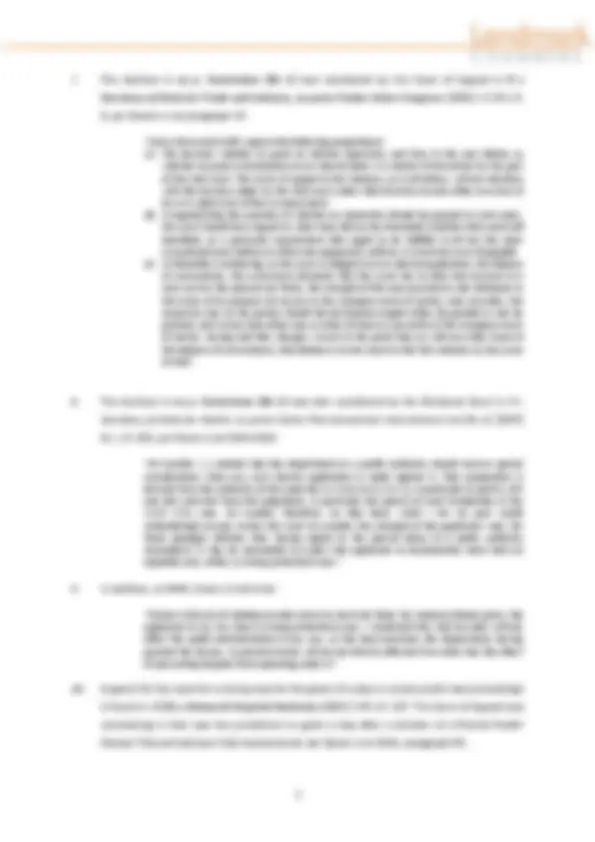
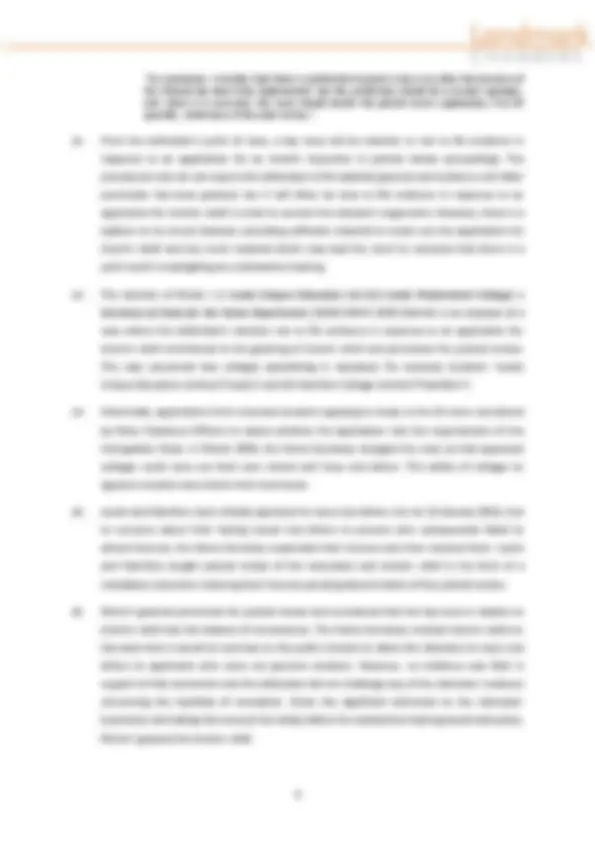
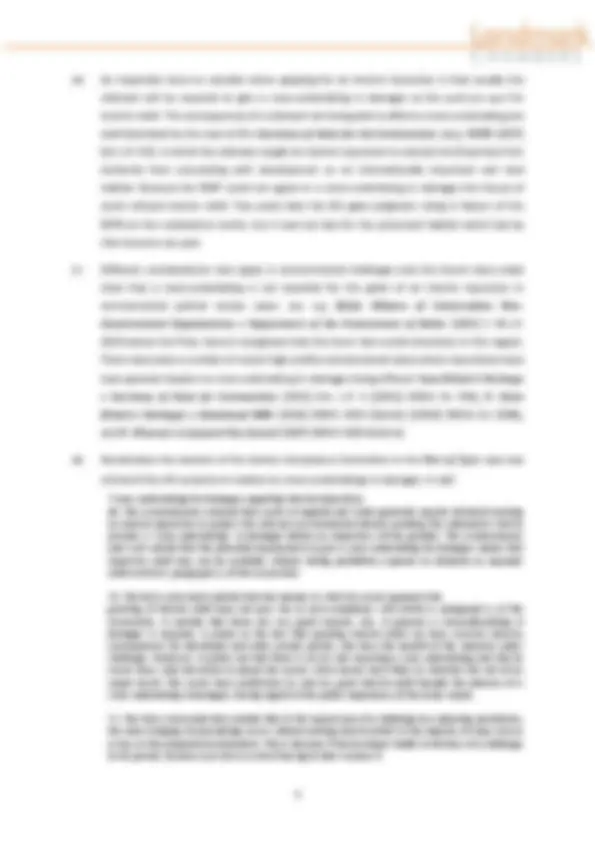
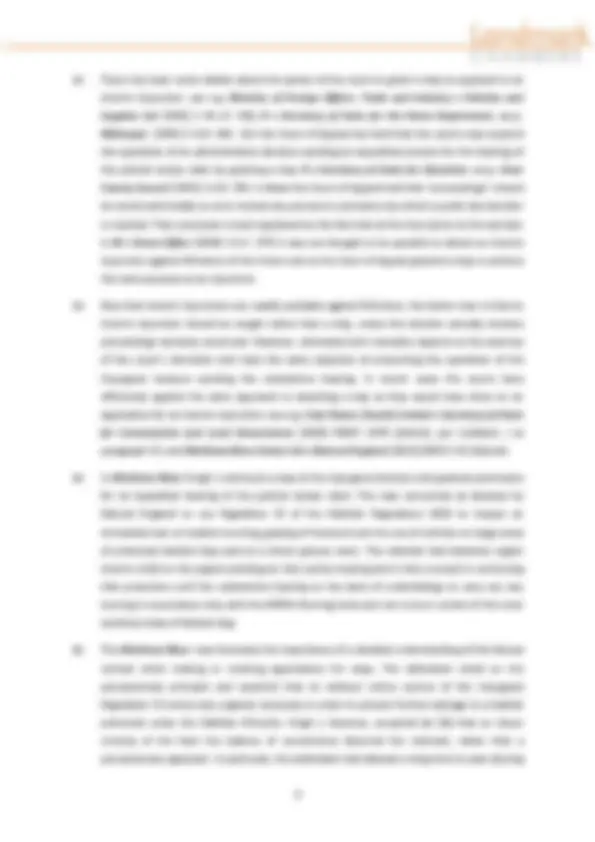
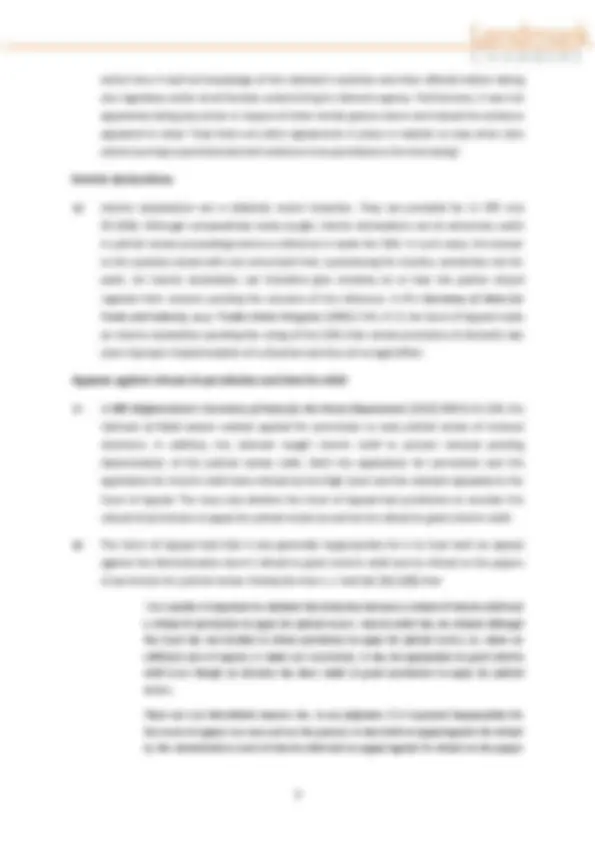
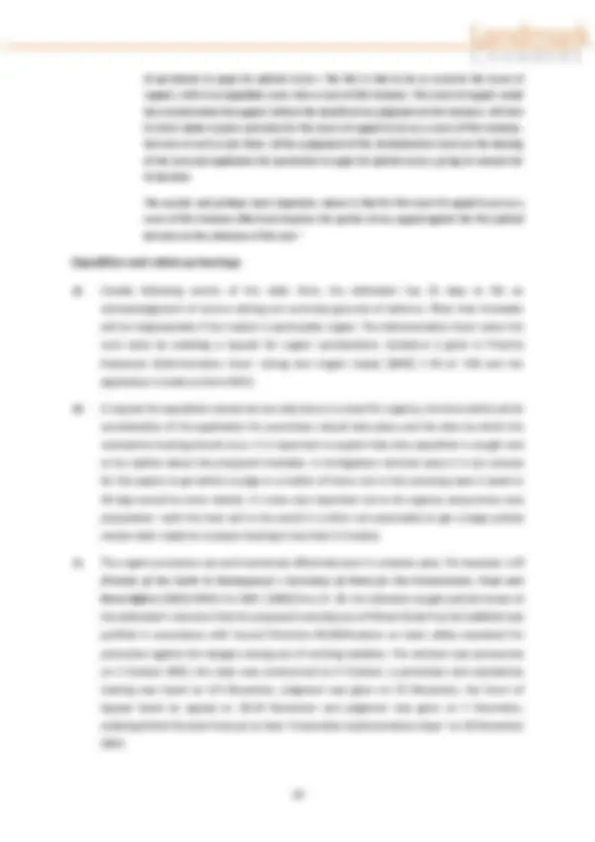
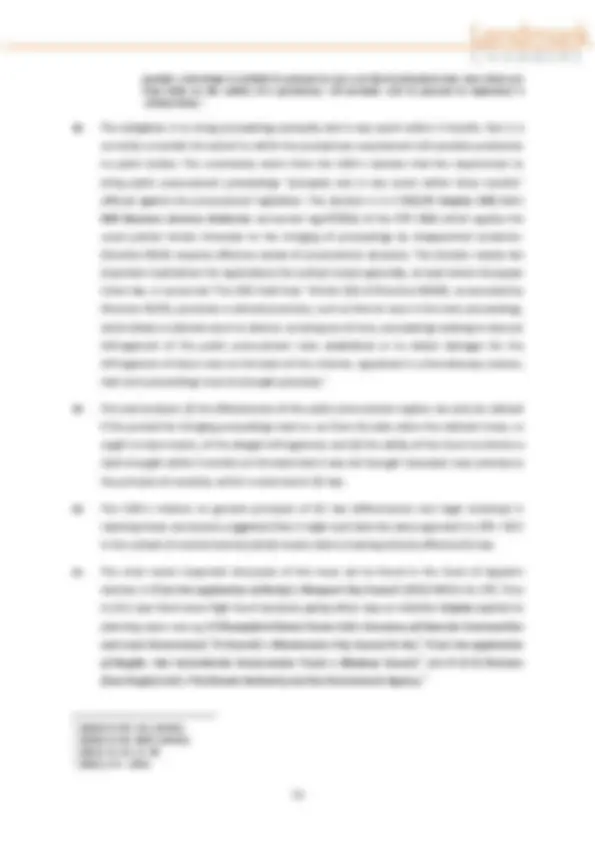
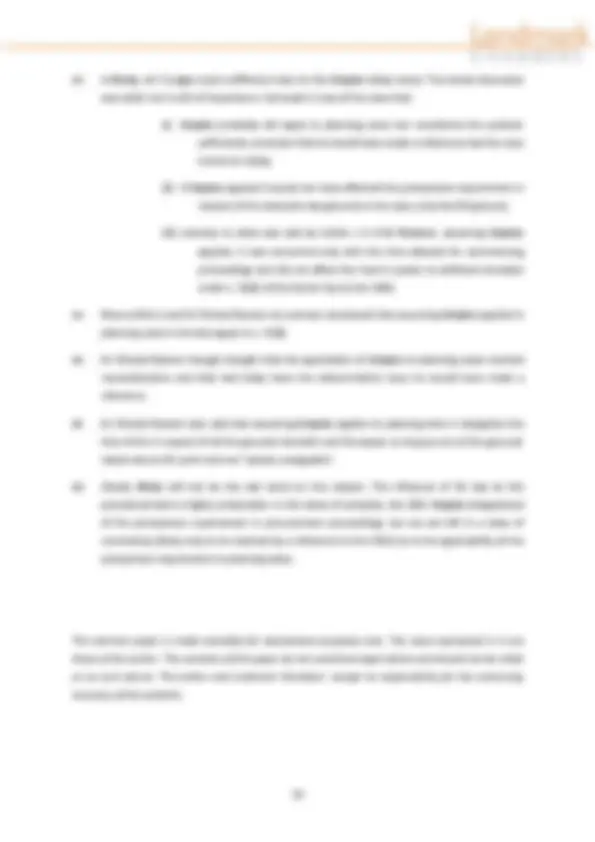


Study with the several resources on Docsity

Earn points by helping other students or get them with a premium plan


Prepare for your exams
Study with the several resources on Docsity

Earn points to download
Earn points by helping other students or get them with a premium plan
Community
Ask the community for help and clear up your study doubts
Discover the best universities in your country according to Docsity users
Free resources
Download our free guides on studying techniques, anxiety management strategies, and thesis advice from Docsity tutors
The principles of interim relief in the context of judicial review, emphasizing the strong presumption against granting relief in public law matters and the role of cross-undertakings for damages. The text also explores cases where the absence of a cross-undertaking did not prevent the granting of interim relief, and the current debate surrounding the requirement for such undertakings in environmental cases. valuable insights into the complexities of interim relief in the context of judicial review and the evolving legal landscape.
What you will learn
Typology: Exercises
1 / 14

This page cannot be seen from the preview
Don't miss anything!









(^1) Thanks to Richard Moules for assisting with the drafting of this paper.
Lords in American Cyanamid […], but with modifications appropriate to the public law element of the case. The public law element is one of the possible “special factors” referred to by Lord Diplock in that case, at p409. Another special factor might be if the grant of refusal of interim relief were likely to be, in practical terms, decisive of the whole case; but neither side suggested that the present case is in that category.”
“To summarise, I consider that there is jurisdiction to grant a stay even after the decision of the tribunal has been fully implemented. But the jurisdiction should be exercised sparingly, and where it is exercised, the court should decide the judicial review application, if at all possible, within days of the order of stay.”
critical of the UK’s practice in relation to cross-undertakings in damages. It said: “Cross-undertakings for damages regarding interim injunctions
a final judgment in the matter would be impossible to enforce because the factual basis of the proceedings will have been eroded and bringing the case on quickly for trial would not resolve the problem; significant environmental damage would be caused; and the claimant would probably and reasonably discontinue proceedings or the application for an interim injunction if a cross-undertaking in damages was required.”
expressed that the proposals would only apply to Public Participation Directive cases. The response continued: “• We welcome the proposal to dispense with the requirement for a cross-undertaking in damages in certain circumstances, however, we foresee significant problems with the present wording of paragraph 39, including: (a) “A final judgment in the matter would be impossible to enforce because the factual basis of the proceedings will have been eroded and bringing the case on quickly for trial would not resolve the problem” – in our view this sets the bar very high. This would only really catch cases where the damage done would be entirely irreversible (e.g. the outright destruction of a protected area, for example) and not those cases where the damage could (but would be unlikely in practice) to be reversed by the court if the case succeeded. Thus, for example, if the challenge is to a landfill consent then, in theory, waste placed without permission in a landfill during the litigation could later be removed but the court is likely to be reluctant to order that and it is questionable whether it would cross the “impossibility” threshold. (b) “Significant environmental damage would be caused” – the qualification “significant” would need explanation to ensure a consistency of approach; factors to be taken into account would need to include the reversibility of the damage (including, in particular, whether the court or other decision-maker would be likely to require its reversal in the event that the claim was successful ), the scale of the damage, whether it relates to something (an area, a species, etc) that has special protection (e.g. under planning policies or the law). (c) “The claimant would probably and reasonably discontinue proceedings or the application for an interim injunction if a cross-undertaking in damages was required” – the issue here is how will the court decide whether a claimant is acting reasonably? Unless, as seems unlikely, the court would simply accept the claimant's statement to that effect, it is inevitable that judges will drawn into a detailed means assessment as to what a claimant can afford in each particular case. In our view, this could lead to significant uncertainty and further unhelpful satellite litigation.
of permission to apply for judicial review. The first is that to do so converts the Court of Appeal, which is an appellate court, into a court of first instance. The Court of Appeal would have to determine the appeal without the benefit of any judgment at first instance. CPR Part 52.15(4) makes express provision for the Court of Appeal to act as a court of first instance, but even in such a case there will be a judgment of the Administrative Court on the hearing of the renewed application for permission to apply for judicial review, giving its reasons for its decision. The second, and perhaps more important, reason is that for the Court of Appeal to act as a court of first instance effectively deprives the parties of any appeal against the first judicial decision on the substance of the case.”
Usually following service of the claim form, the defendant has 21 days to file an acknowledgement of service setting out summary grounds of defence. Often that timetable will be inappropriate if the matter is particularly urgent. The Administrative Court caters for such cases by enabling a request for urgent consideration. Guidance is given in Practice Statement (Administrative Court: Listing and Urgent Cases) [2002] 1 W.L.R. 810 and the application is made on form N463.
A request for expedition should set out why there is a need for urgency, the time within which consideration of the application for permission should take place and the date by which the substantive hearing should occur. It is important to explain fully why expedition is sought and to be realistic about the proposed timetable. In immigration removal cases it is not unusual for the papers to go before a judge in a matter of hours, but in less pressing cases 1 week to 10 days would be more realistic. It is also very important not to let urgency compromise case preparation – with the best will in the world it is often not practicable to get a large judicial review claim ready for a proper hearing in less than 2-3 weeks.
The urgent procedure can work extremely effectively even in complex cases. For example, in R (Friends of the Earth & Greenpeace) v Secretary of State for the Environment, Food and Rural Affairs [2001] EWCA Civ 1847, [2002] Env L.R. 24, the claimants sought judicial review of the defendant’s decision that the proposed manufacture of Mixed Oxide Fuel at Sellafield was justified in accordance with Council Directive 96/29/Euratom on basic safety standards for protection against the dangers arising out of ionising radiation. The decision was announced on 3 October 2001, the claim was commenced on 5 October, a permission and substantive hearing was heard on 8-9 November, judgment was given on 15 November, the Court of Appeal heard an appeal on 28-29 November and judgment was given on 7 December, enabling British Nuclear Fuels plc to take “irreversible implementation steps” on 20 December
Another way to achieve some measure of expedition is to seek a rolled-up permission and substantive hearing whereby the court will list the permission and substantive hearings together to be heard at an oral hearing. Rolled-up hearings are increasingly common in important, urgent cases. For example in R (Westminster City Council) v Mayor of London [2002] EWHC 2440 (Admin) a rolled-up hearing was held to consider a judicial review claim challenging the introduction of the London congestion charge.
A rolled-up hearing may also be appropriate where an oral permission hearing has been
adjourned thereby avoiding further delay. For example, in R (on the application of Midlands Co-operative Society Ltd) v Birmingham City Council [2012] EWHC 620 (Admin), the Co-Op challenged the decision by Birmingham City Council to sell certain strategic land interests in Stirchley to Tesco, as well as the in principle authorisation of the use of compulsory purchase powers to facilitate land assembly for Tesco’s proposal for retail-led regeneration of Stirchley. The Co-Op has an existing retail store in Stirchley as well as planning permission for a different scheme. The claim was brought on a number of grounds, including in particular that the transaction, viewed in conjunction with planning obligations that Tesco had entered into relating to the relocation of a community centre and bowling facility currently located at the site, was a “public works contract” engaging the public procurement rules in the Public Contracts Directive and the PCR 2006. Beatson J heard a day’s argument at the oral permission stage, but could not reach a decision. The matter was then listed before Hickinbottom J for a rolled-up hearing where, in a day and a half, he granted the Co-Op permission to proceed but dismissed the substantive claim.
granted, a developer is entitled to proceed to carry out the development and, since there are time limits on the validity of a permission, will normally wish to proceed to implement it without delay.”
(^3) [2010] EWHC 131 (Admin). (^4) [2010] EWHC 2019 (Admin). (^5) [2011] 3 C.M.L.R. 39. (^6) [2011] J.P.L. 1583.
This seminar paper is made available for educational purposes only. The views expressed in it are those of the author. The contents of this paper do not constitute legal advice and should not be relied on as such advice. The author and Landmark Chambers accept no responsibility for the continuing accuracy of the contents.